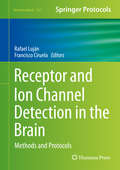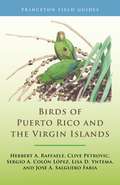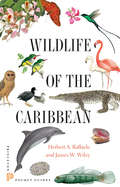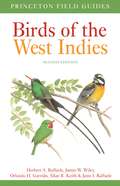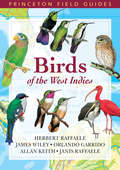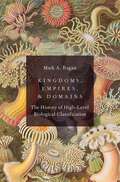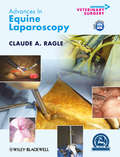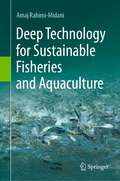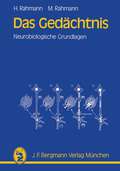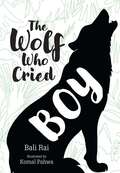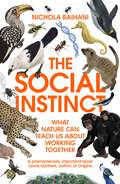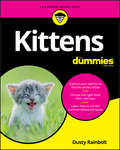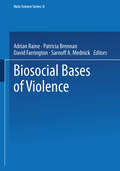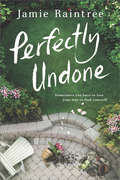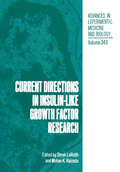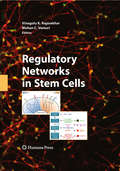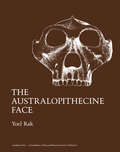- Table View
- List View
Receptor and Ion Channel Detection in the Brain: Methods and Protocols (Neuromethods #110)
by Rafael Luján and Francisco CiruelaReceptor and Ion Channel Detection in the Brain provides state-of-the-art and up-to-date methodological information on molecular, neuroanatomical and functional techniques that are currently used to study neurotransmitter receptors and ion channels in the brain. The chapters have been contributed by world-wide recognized neuroscientists who explain in an easy and detailed way well established and tested protocols embracing molecular, cellular, subcellular, anatomical and electrophysiological aspects of the brain. This comprehensive and practical manual is presented in a simple, step-by-step manner for laboratory use, and also offers unambiguous detail and key implementation advice that proves essential for successful results and facilitate choosing the best method for the target proteins under study. This work serves as a useful guide for young researchers and students in training as well as for neurologists and established scientists who wish to extend their repertoire of techniques.
Birds of Puerto Rico and the Virgin Islands: Fully Revised and Updated Third Edition (Princeton Field Guides #153)
by Birds of the Wes Herbert A. Raffaele Clive Petrovic Sergio A. López Lisa D. Yntema José A. FariaThe only fully illustrated guide to feature all the bird species of Puerto Rico and the Virgin IslandsThis portable and informative field guide describes the bird species found on Puerto Rico and the Virgin Islands. Fully updated, the guide presents all 347 species, both naturally occurring as well as introduced, and highlights 19 endemic species found nowhere else in the world. Species are sorted by habitat to facilitate identification and extra illustrations are provided for birds similar in appearance.The only fully illustrated guide to feature all 347 bird species in Puerto Rico and the Virgin IslandsSpecies sorted by habitat for easier identificationText and illustrations on facing pages for ease of identificationExtensive introduction covering taxonomy, migration, biogeography, and conservationUseful information on birding hotspots throughout the region
Wildlife of the Caribbean
by Birds of the Wes Herbert A. Raffaele James WileyThe essential guide to the living wonders of the Caribbean islandsThis is the first comprehensive illustrated guide to the natural world of the Caribbean islands. It contains 600 vivid color images featuring 451 species of plants, birds, mammals, fish, seashells, and much more. While the guide primarily looks at the most conspicuous and widespread species among the islands, it also includes rarely seen creatures—such as the Rhinoceros Iguana and Cuban Solenodon—giving readers a special sense of the region's diverse wildlife.Each species is represented by one or more color photos or illustrations; details regarding its identification, status, and distribution; and interesting aspects of its life history or relationship to humans. In addition, an introductory section focuses on the unique characteristics of the Caribbean’s fauna and flora, the threats faced by both, and some of the steps being taken to sustain the area’s extraordinary natural heritage.Wildlife of the Caribbean is the essential field guide for learning about the living wonders in this area of the world.The only guide of its kind for the Caribbean islands600 detailed color images feature 451 amazing speciesStraightforward descriptions suitable for general audienceCompact size makes the guide easy to carry
Birds of the West Indies Second Edition (Princeton Field Guides #143)
by Birds of the Wes Herbert A. Raffaele James Wiley Orlando H. Garrido Allan Keith Janis I. RaffaeleAn updated edition of the acclaimed field guide to the spectacular birds of the West IndiesBirds of the West Indies is the first field guide that covers and depicts all birds known to occur in the region, including infrequently occurring and introduced forms. Now fully updated and expanded, this stunningly illustrated book features detailed accounts of more than 600 species, describing identification field marks, range, status, voice, and habitat. There are more than 100 beautiful color plates that depict plumages of all species—including those believed to have recently become extinct—as well as distribution maps, a color code for endemic birds, and an incisive introduction that discusses avifaunal changes in the West Indies in the past fifteen years and the importance of conservation.Covers more than 60 new species, including vagrants, introductions, and taxonomic splitsUpdates the status of every speciesFeatures illustrations for all new species and improved artwork for warblers and flycatchersColor codes endemic species confined to one or just a few islandsIncludes many new and enhanced mapsProvides bird weights for each speciesCompact and easy to use in the field
Wildlife of the Caribbean
by Herbert A. Raffaele James WileyThis is the first comprehensive illustrated guide to the natural world of the Caribbean islands. It contains 600 vivid color images featuring 451 species of plants, birds, mammals, fish, seashells, and much more. While the guide primarily looks at the most conspicuous and widespread species among the islands, it also includes rarely seen creatures—such as the Rhinoceros Iguana and Cuban Solenodon—giving readers a special sense of the region's diverse wildlife.Each species is represented by one or more color photos or illustrations; details regarding its identification, status, and distribution; and interesting aspects of its life history or relationship to humans. In addition, an introductory section focuses on the unique characteristics of the Caribbean’s fauna and flora, the threats faced by both, and some of the steps being taken to sustain the area’s extraordinary natural heritage.Wildlife of the Caribbean is the essential field guide for learning about the living wonders in this area of the world.The only guide of its kind for the Caribbean islands600 detailed color images feature 451 amazing speciesStraightforward descriptions suitable for general audienceCompact size makes the guide easy to carry
Birds of the West Indies
by Herbert A. Raffaele James Wiley Orlando H. Garrido Allan Keith Janis I. Raffaele Tracy Pedersen Kristin WilliamsFully illustrated, easy to use, and completely up-to-date, Birds of the West Indies is the only field guide that covers all of the bird species known to occur in the region--including migrants and infrequently occurring forms. Each species is represented by a full description that includes identification field marks, status and range, habitat, and voice. A map showing the bird's distribution accompanies many species accounts, and plumages of all species are depicted in ninety-three beautifully rendered color plates. Bird lovers, vacationing tourists, local residents, and "armchair travelers" will all want to own this definitive field guide to the birds of the West Indies. Includes all species recorded in the region Features ninety-three color plates with concise text on facing pages for quick reference and easy identification Species accounts cover identification, voice, status and habitat, and range Color distribution maps
Birds of the West Indies (PDF)
by Herbert A. Raffaele James Wiley Orlando H. Garrido Allan Keith Janis I. Raffaele Tracy Pedersen Kristin WilliamsFully illustrated, easy to use, and completely up-to-date, Birds of the West Indies is the only field guide that covers all of the bird species known to occur in the region--including migrants and infrequently occurring forms. Each species is represented by a full description that includes identification field marks, status and range, habitat, and voice. A map showing the bird's distribution accompanies many species accounts, and plumages of all species are depicted in ninety-three beautifully rendered color plates. Bird lovers, vacationing tourists, local residents, and "armchair travelers" will all want to own this definitive field guide to the birds of the West Indies. Includes all species recorded in the region Features ninety-three color plates with concise text on facing pages for quick reference and easy identification Species accounts cover identification, voice, status and habitat, and range Color distribution maps
Mechanisms of Lymphocyte Activation and Immune Regulation VII: Molecular Determinants of Microbial Immunity (Advances in Experimental Medicine and Biology #452)
by RafiAhmed AlanSher SudhirGuptaProceedings of the Seventh International Conference held in New Port Beach, California, February 6-8, 1998
Kingdoms, Empires, and Domains: The History of High-Level Biological Classification
by Mark A. RaganA generation or two before Socrates, thinkers classified the world's organisms into three categories: plants, animals, and man. However, Aristotle recognized that some organisms, such as sponges and sea-fans, share properties of both plants and animals. These became known as zoophytes. Since then, scientists have explored the idea of a "third kingdom." In Kingdoms, Empires, and Domains, leading molecular systematist Mark A. Ragan offers a history of the idea that there is more to the living world than plants and animals. Progressing chronologically through philosophical, religious, literary, and other pre-scientific traditions, Ragan traces how transgressive creatures such as sponges, corals, algae, fungi, and diverse microscopic beings have been described, categorized, and understood throughout history. The book considers their appearance in early Christian, Islamic, and Jewish traditions; myths, legends, and traveller's tales; occult literature; and more. Kingdoms, Empires, and Domains also details how the concept of a "third kingdom" has evolved throughout the history of scientific botany and zoology, and continues to evolve up to the present day. Kingdoms, Empires, and Domains features original translations of passages from key historical texts, many of which have never appeared in English before. It also draws on the most recent and reliable scientific literature. A sweeping, interdisciplinary study, Kingdoms, Empires, and Domains is essential reading for students and scholars of the history of biological classification and anyone interested in the history of ideas about the natural world.
Kingdoms, Empires, and Domains: The History of High-Level Biological Classification
by Mark A. RaganA generation or two before Socrates, thinkers classified the world's organisms into three categories: plants, animals, and man. However, Aristotle recognized that some organisms, such as sponges and sea-fans, share properties of both plants and animals. These became known as zoophytes. Since then, scientists have explored the idea of a "third kingdom." In Kingdoms, Empires, and Domains, leading molecular systematist Mark A. Ragan offers a history of the idea that there is more to the living world than plants and animals. Progressing chronologically through philosophical, religious, literary, and other pre-scientific traditions, Ragan traces how transgressive creatures such as sponges, corals, algae, fungi, and diverse microscopic beings have been described, categorized, and understood throughout history. The book considers their appearance in early Christian, Islamic, and Jewish traditions; myths, legends, and traveller's tales; occult literature; and more. Kingdoms, Empires, and Domains also details how the concept of a "third kingdom" has evolved throughout the history of scientific botany and zoology, and continues to evolve up to the present day. Kingdoms, Empires, and Domains features original translations of passages from key historical texts, many of which have never appeared in English before. It also draws on the most recent and reliable scientific literature. A sweeping, interdisciplinary study, Kingdoms, Empires, and Domains is essential reading for students and scholars of the history of biological classification and anyone interested in the history of ideas about the natural world.
Advances in Equine Laparoscopy (AVS Advances in Veterinary Surgery #3)
by Claude RaglePart of the Advances in Veterinary Surgery series copublished with the ACVS Foundation and Wiley-Blackwell, Advances in Equine Laparoscopy presents a state-of-the-art reference on laparoscopic skills and procedures in the horse. Chapters are written by the leading experts in the field, and each section includes a practical review of the published literature. Encompassing instrumentation, basic principles, and specific techniques, Advances in Equine Laparoscopy offers an up-to-date, reliable resource for comprehensive information about equine laparoscopy. This current, well-referenced text begins with a section on the fundamentals of laparoscopy, then moves into sections on the clinical application of laparoscopic techniques in the standing or recumbent horse. A companion website offers eight video clips demonstrating selected procedures at www.wiley.com/go/ragle. Advances in Equine Laparoscopy is an invaluable guide for equine surgical specialists and equine clinicians interested in laparoscopic techniques.
Advances in Equine Laparoscopy (AVS Advances in Veterinary Surgery)
by Claude A. RaglePart of the Advances in Veterinary Surgery series copublished with the ACVS Foundation and Wiley-Blackwell, Advances in Equine Laparoscopy presents a state-of-the-art reference on laparoscopic skills and procedures in the horse. Chapters are written by the leading experts in the field, and each section includes a practical review of the published literature. Encompassing instrumentation, basic principles, and specific techniques, Advances in Equine Laparoscopy offers an up-to-date, reliable resource for comprehensive information about equine laparoscopy. This current, well-referenced text begins with a section on the fundamentals of laparoscopy, then moves into sections on the clinical application of laparoscopic techniques in the standing or recumbent horse. A companion website offers eight video clips demonstrating selected procedures at www.wiley.com/go/ragle. Advances in Equine Laparoscopy is an invaluable guide for equine surgical specialists and equine clinicians interested in laparoscopic techniques.
Deep Technology for Sustainable Fisheries and Aquaculture
by Amaj Rahimi-MidaniThis book uses real-world examples from the aquaculture industry to demonstrate how deep technology is assisting farmers and vulnerable communities. Works conducted by Poseidon-AI (a deep tech company involved in the aquaculture sector) in different countries are presented as case studies to show the positive impacts of deep tech involvement in the aquaculture sector. Primary industries, such as fisheries and aquaculture, rely heavily on labor. Furthermore, the manual practices of these farming methods increase material waste and reduce yields, resulting in higher costs and lower revenues. Poikilotherms make up the majority of aquatic animals, and environmental changes have a significant impact on them. This means that, due to climate change, farming of these animals cannot continue in the same way that it has for centuries. Artificial intelligence, machine learning, image processing, sensing, and automation are approaches that can assist these farms in dealing with rapid environmental changes while also assisting farmers in growing their businesses sustainably. This book is of interest to climate change scientists, entrepreneurs, investors, civil workers, and policymakers. Furthermore, the book is a great complimentary material for graduate students of fisheries, aquaculture, ecology, soil science, water management and environmental sciences. All national and international policymakers working in implementation of UNSDGs and sustainability, will find this book a useful read.
Das Gedächtnis: Neurobiologische Grundlagen
by Hinrich Rahmann Mathilde RahmannDie Erforschung des Gedächtnisses rückt in immer stärkerem Maß in das Zentrum des allgemeinen Interesses unserer Gesellschaft. Ziel dieses Buches ist es, über die bisher von den verschiedensten Disziplinen der Neurobiologie erarbeiteten Grundlagen der Gedächtnisforschung in einem überschaubaren Umfang und allgemein verständlich zu informieren. Das Buch setzt keine spezifischen Kenntnisse voraus. Neu eingeführte wissenschaftliche Begriffe werden jeweils erläutert. Ausgehend von den Erkenntnissen der vergleichenden Anatomie, Histologie, Cytologie sowie den wichtigsten Grundlagen der Neurophysiologie, Neurochemie und der Verhaltensforschung werden einige derzeit häufiger diskutierte Gedächtnishypothesen referiert. Das Funktionsmodell einer Gedächtnisbildung wird durch molekulare Bahnung in den Synapsen erläutert. Dabei spielen die funktionsmorphologische Plastizität der Nervenendigungen sowie die Anpassungsfähigkeit von wichtigen Stoffwechselvorgängen der Synapse eine große Rolle.
The Social Instinct: How Cooperation Shaped the World
by Nichola RaihaniWhy cooperate? This may be the most important scientific question we have ever, and will ever, face. The science of cooperation tells us not only how we got here, but also where we might end up. Cooperation explains how strands of DNA gave rise to modern-day nation states. It defines our extraordinary ecological success as well as many of the most surprising features of what make us human: not only why we live in families, why we have grandmothers and why women experience the menopause, but also why we become paranoid and jealous, and why we cheat. Nichola Raihani also introduces us to other species who, like us, live and work together. From the pied babblers of the Kalahari to the cleaner fish of the Great Barrier Reef, they happen to be some of the most fascinating and extraordinarily successful species on this planet. What do we have in common with these other species, and what is it that sets us apart?Written at a time of global pandemic, when the challenges and importance of cooperation have never been greater, The Social Instinct is an exhilarating, far-reaching and thought-provoking journey through all life on Earth, with profound insights into what makes us human and how our societies work.
Kittens For Dummies
by Dusty RainboltKittens For Dummies (9781119609117) was previously published as Kittens For Dummies (9780764541506). While this version features a new Dummies cover and design, the content is the same as the prior release and should not be considered a new or updated product. Who can resist the charm of a kitten, those energetic, curious creatures whose cuteness factors fall somewhere between adorable and irresistible? But as animal shelters across the country can attest, those enchanting balls of fluff quickly mature into full-grown cats with their own requirements for healthy, happy lives. Kittens For Dummies is your source for understanding what you can expect if you decide to welcome a high energy and high maintenance four-legged friend into your home. You'll not only figure out if you're ready to fit a kitty into your lifestyle, but also how to go about Adopting or buying the right kitten for you Making sure your home is kitten-proof Introducing your new pet to children and other pets Preventing and treating feline illnesses Dealing with behavioral issues Rescuing an orphaned kitten Books abound about kitten care. Unlike many of them—those that seem to require a veterinary medicine degree to figure out—Kittens For Dummies explains everything in plain, everyday English. And like the subject itself, this handy reference is full of fun. In entertaining, informative language, the friendly guide gives you the real deal on Doling out plenty of love, attention, and patience Deciding whether kitty will be allowed to explore the outdoors Making your kitten comfy with the right supplies and accessories Knowing how often to ring the dinner bell Recognizing emergencies that call for quick trips to the veterinarian Locating qualified caretakers when you travel Nurturing kitty into adulthood Before you take the giant leap into kitten ownership—a wonderful and sometimes chaotic world—check out the expert advice in a resource that's bound to become as constant a companion as your purr-fect pet.
Kittens For Dummies
by Dusty RainboltKittens For Dummies (9781119609117) was previously published as Kittens For Dummies (9780764541506). While this version features a new Dummies cover and design, the content is the same as the prior release and should not be considered a new or updated product. Who can resist the charm of a kitten, those energetic, curious creatures whose cuteness factors fall somewhere between adorable and irresistible? But as animal shelters across the country can attest, those enchanting balls of fluff quickly mature into full-grown cats with their own requirements for healthy, happy lives. Kittens For Dummies is your source for understanding what you can expect if you decide to welcome a high energy and high maintenance four-legged friend into your home. You'll not only figure out if you're ready to fit a kitty into your lifestyle, but also how to go about Adopting or buying the right kitten for you Making sure your home is kitten-proof Introducing your new pet to children and other pets Preventing and treating feline illnesses Dealing with behavioral issues Rescuing an orphaned kitten Books abound about kitten care. Unlike many of them—those that seem to require a veterinary medicine degree to figure out—Kittens For Dummies explains everything in plain, everyday English. And like the subject itself, this handy reference is full of fun. In entertaining, informative language, the friendly guide gives you the real deal on Doling out plenty of love, attention, and patience Deciding whether kitty will be allowed to explore the outdoors Making your kitten comfy with the right supplies and accessories Knowing how often to ring the dinner bell Recognizing emergencies that call for quick trips to the veterinarian Locating qualified caretakers when you travel Nurturing kitty into adulthood Before you take the giant leap into kitten ownership—a wonderful and sometimes chaotic world—check out the expert advice in a resource that's bound to become as constant a companion as your purr-fect pet.
Biosocial Bases of Violence (Nato Science Series A: #292)
by Adrian Raine Patricia Brennan David P. Farrington Sarnoff A. MednickProceedings of a NATO ASI held in Rhodes, Greece, May 12-21, 1996
Perfectly Undone: Something Like Happy Best Day Ever Perfectly Undone House Of Shadows (Hq Digital Ser.)
by Jamie RaintreeSometimes you have to lose your way to find yourself
Current Directions in Insulin-Like Growth Factor Research (Advances in Experimental Medicine and Biology #343)
by Mohan K. Raizada DerekRoithThe study of the insulin-like growth factor (IGF) family has become an exciting area of investigation. Initially, this family consisted of ligands (insulin, IGF-I and IGF-m and receptors (the insulin receptor, the type I or IGF-I receptor and the type II or IGF-IYM-6-P receptor). Subsequently, it was discovered that six specific binding proteips (lGFBPs 1-6) playa major role in the actions of this growth factor family. In addition, there are now more potential receptors when one considers the possible roles of the insulin-receptor related receptor (IRR) and hybrid receptor dimers composed of insulin and IGF-I receptor (half-receptors). Another important aspect of this area of research is the realization that the IGFs are not only essential for normal growth and development but, in addition play an important role in the normal specialized function(s) of all tissues of the body, including the nervous system, skeleton, reproductive system, kidney, and the immune system, to name but a few. The development of recombi!tant human IGF-I for clinical testing has been a major breakthrough for investigators. Potential uses include wound healing, reversal of catabolic states, diabetes, bone remodeling, recovery from acute renal failure and many others. will determine both its use and its potential hazards.
Recent Advances in Cellular and Molecular Aspects of Angiotensin Receptors (Advances in Experimental Medicine and Biology #396)
by Mohan K. Raizada M. Ian Phillips Colin SumnersScientific advances over the past two decades have afforded unprecedented oppor tunities to understand the structure and function of receptors, receptor-ligand interactions, and receptor signaling. The extent ofprogress in this area is underscored by the recent Nobel Prize for Medicine and Physiology to Alfred Gilman and Martin Rodbell, both of whose work in understanding receptorlG-protein interactions has redefined the way in which we think of how hormones and neurochemicals exert their activity on cellular function. This book is replete with examples of current research approaches to help us better understand the cellular roles in which the renin-angiotensin system and the angiotensin receptors participate. Clearly, defining the structure of angiotensin receptor subtypes is an important first step in cJarifying the mechanisms by which these receptors take part in cellular function. However, the chapters within this book range far beyond structural studies and encompass research on tissue specific expression of the angiotensin receptor subtypes, the genetic regulation ofthese receptors, and the unique function ofvarious angiotensin subtypes in different organ systems, such as the brain, the reproductive system, adipose tissue, the heart, and the kidneys.
Regulatory Networks in Stem Cells (Stem Cell Biology and Regenerative Medicine)
by Vinagolu K. Rajasekhar Mohan C. VemuriStem cells appear to be fundamental cellular units associated with the origin of multicellular organisms and have evolved to function in safeguarding the cellular homeostasis in organ t- sues. The characteristics of stem cells that distinguish them from other cells have been the fascinating subjects of stem cell research. The important properties of stem cells, such as ma- tenance of quiescence, self-renewal capacity, and differentiation potential, have propelled this exciting ?eld and presently form a common theme of research in developmental biology and medicine. The derivation of pluripotent embryonic stem cells, the prospective identi?cation of multipotent adult stem cells, and, more recently, the induced pluripotent stem cells (popularly called iPS) are important milestones in the arena of stem cell biology. Complex networks of transcription factors, different signaling molecules, and the interaction of genetic and epi- netic events constantly modulate stem cell behavior to evoke programming and reprogramming processes in normal tissue homeostasis during development. In any given cellular scenario, the regulatory networks can pose considerable complexity and yet exert an orderly control of stem cell differentiation during normal development. An aberration in these ?nely tuned processes during development usually results in a spectrum of diseases such as cancers and neurological disorders. Thisunderscorestheimminentneedforamorecompleteunderstandingofmolecular mechanisms underlying the regulatory circuitries required for stem cell maintenance. Overthepast3–5years,adiversegroupofbenchandphysicianscientistshaveprospectively enhanced our knowledge of stem cell biology. These studies are unveiling many unrecognized or previously unknown fundamentals of developmental biology.
The Australopithecine Face
by Yoel RakThe Australopithecine Face provides an introduction to the interpretation of the facial skeleton of Australopithecus, a part of the anatomy well represented in the African collections. This book presents important morphological differences between the early hominid taxa and interprets them in a biochemical, functional, evolutionary framework.Organized into seven chapters, this book begins with an overview of the description of the face of the four species of Australopithecus, extending to comparisons both within the genus and with other primates. This text then provides an analysis of the facial morphology of Australopithecus in terms of structural significance. Other chapters consider the taxonomic and phylogenetic status of the australopithecine species in light of the description and comparison. This book discusses as well the changes in the morphology and topography of the facial mask. The final chapter deals with the phylogenetic assignment of the different species.This book is a valuable resource for anthropologists.
Stem Cells and Human Diseases
by Rakesh Srivastava and Sharmila ShankarThe main objective of this book is to provide a comprehensive review on stem cells and their role in tissue regeneration, homeostasis and therapy. In addition, the role of cancer stem cells in cancer initiation, progression and drug resistance are discussed. The cell signaling pathways and microRNA regulating stem cell self-renewal, tissue homeostasis and drug resistance are also mentioned. Overall, these reviews will provide a new understanding of the influence of stem cells in tissue regeneration, disease regulation, therapy and drug resistance in several human diseases.
